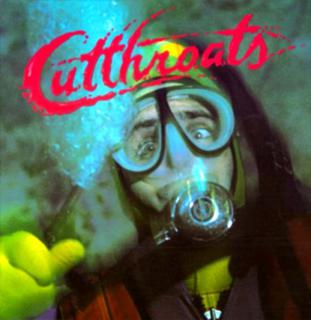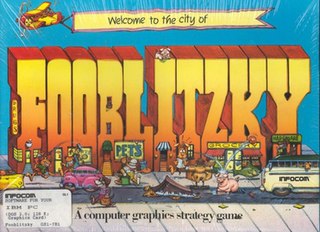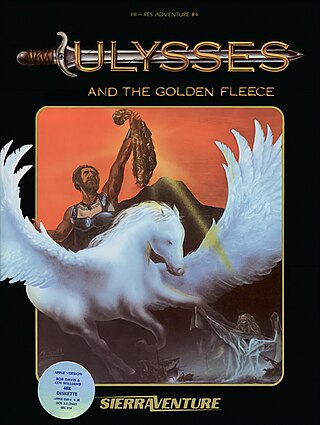Infocom was an American software company based in Cambridge, Massachusetts, that produced numerous works of interactive fiction. They also produced a business application, a relational database called Cornerstone.
Interactive fiction, often abbreviated IF, is software simulating environments in which players use text commands to control characters and influence the environment. Works in this form can be understood as literary narratives, either in the form of Interactive narratives or Interactive narrations. These works can also be understood as a form of video game, either in the form of an adventure game or role-playing game. In common usage, the term refers to text adventures, a type of adventure game where the entire interface can be "text-only", however, graphical text adventure games, where the text is accompanied by graphics still fall under the text adventure category if the main way to interact with the game is by typing text. Some users of the term distinguish between interactive fiction, known as "Puzzle-free", that focuses on narrative, and "text adventures" that focus on puzzles.

Zork is a text adventure game first released in 1977 by developers Tim Anderson, Marc Blank, Bruce Daniels, and Dave Lebling for the PDP-10 mainframe computer. The original developers and others, as the company Infocom, expanded and split the game into three titles—Zork I: The Great Underground Empire, Zork II: The Wizard of Frobozz, and Zork III: The Dungeon Master—which were released commercially for a range of personal computers beginning in 1980. In Zork, the player explores the abandoned Great Underground Empire in search of treasure. The player moves between the game's hundreds of locations and interacts with objects by typing commands in natural language that the game interprets. The program acts as a narrator, describing the player's location and the results of the player's commands. It has been described as the most famous piece of interactive fiction.

Suspended: A Cryogenic Nightmare is an interactive fiction video game written by Michael Berlyn and published by Infocom in 1983. Infocom's sixth game, it was released for Amstrad CPC, Apple II, Atari 8-bit computers, Commodore 64, Commodore Plus/4, IBM PC compatibles, TRS-80, and TI-99/4A. It was later available for Mac, Amiga, and Atari ST.

Return to Zork is a 1993 graphic adventure game in the Zork series. It was developed by Activision and was the final Zork game to be published under the Infocom label.

Planetfall is a science fiction themed interactive fiction video game written by Steve Meretzky, and published in 1983 as the eighth game from Infocom. The original release was for Apple II, Atari 8-bit computers, TRS-80, and IBM PC compatibles. Atari ST and Commodore 64 versions were released in 1985. A version for CP/M was also released. Planetfall was Meretzky's first published game, and it proved one of his most popular works and a best-seller for Infocom. It was one of five top-selling games to be re-released in Solid Gold versions with in-game hints. Planetfall uses the Z-machine originally developed for Zork and was added as a bonus to the Zork Anthology.

Deadline is an interactive fiction detective video game published by Infocom in 1982. Written by Marc Blank, it was Infocom's third game. It was released for the Amstrad CPC, Apple II, Atari 8-bit computers, Commodore 64, IBM PC, Osborne 1, TRS-80, and later for the Amiga and Atari ST.

Cutthroats is an interactive fiction game written by Michael Berlyn and Jerry Wolper and was published by Infocom in 1984. It was released for the Amiga, Apple II, Atari 8-bit computers, Atari ST, Commodore 64, MS-DOS, TRS-80, TI-99/4A, and Mac. It is Infocom's thirteenth game.

Seastalker is an interactive fiction game written by Stu Galley and Jim Lawrence and published by Infocom in 1984. It was released simultaneously for several popular computer platforms of the time, such as the Commodore 64, Apple II, and IBM PC compatibles. The game was marketed as an introduction to interactive fiction for preteen players, having difficulty rating of "Junior." It was the only game to ever use this rating, which was replaced by the "Introductory" label given to games such as Wishbringer. It is Infocom's twelfth game.

Stationfall is an interactive fiction game written by Steve Meretzky and released by Infocom in 1987. It was published for the Commodore 64, Amiga, Amstrad CPC, Apple II, Atari 8-bit computers, Atari ST, and MS-DOS. The game is a sequel to Planetfall, one of Infocom's most popular games. It is Infocom's twenty-fifth game.

Moonmist is an interactive fiction game written by Stu Galley and Jim Lawrence and published by Infocom in 1986. The game was released simultaneously for the Amiga, Amstrad CPC, Apple II, Atari 8-bit computers, Atari ST, Commodore 64, MS-DOS, TRS-80, TI-99/4A, and Mac. It is Infocom's twenty-second game. Moonmist was re-released in Infocom's 1995 compilation The Mystery Collection, as well as the 1996 compilation Classic Text Adventure Masterpieces.

Border Zone is an interactive fiction video game written by Marc Blank and published by Infocom in 1987. It was released for DOS, Apple II, Commodore 64, Amiga, Atari ST, and Macintosh. Unlike most other purely text-based games, Border Zone incorporates real-time aspects of gameplay. It is also Infocom's thirtieth game. Its tagline is "Action and international intrigue behind the Iron Curtain."

The Pawn is an interactive fiction game for the Sinclair QL written by Rob Steggles of Magnetic Scrolls and published by Sinclair Research in 1985. In 1986, graphics were added and the game was released for additional home computers by Rainbird.

Fooblitzky is a board game-style video game published by Infocom in 1985 and designed by a team which included interactive fiction authors Marc Blank and Michael Berlyn. It is unique among Infocom titles for not being interactive fiction and for being the first to incorporate graphics beyond ASCII characters. Unlike most Infocom games, it was only released for the Apple II, Atari 8-bit computers, and IBM PC compatibles.

Tass Times in Tonetown is an adventure game published by Activision in 1986. It was designed by Michael Berlyn and Muffy McClung Berlyn and programmed by Rebecca Heineman of Interplay in cooperation with Brainwave Creations.

Marc Blank is an American game developer and software engineer. He is best known as part of the team that created one of the first commercially successful text adventure computer games, Zork. In 2009, he was chosen by IGN as one of the top 100 game creators of all time.
Michael Berlyn was an American video game designer and writer. He was best known as an implementer at Infocom, part of the text adventure game design team. He is also known as the designer behind Bubsy in Claws Encounters of the Furred Kind (1993) and Bubsy 3D (1996).

The Mask of the Sun is a graphical interactive fiction game for the Apple II developed by Ultrasoft and published in 1982 in North America by Broderbund and in Europe by Ariolasoft. Versions for the Atari 8-bit computers and Commodore 64 were released in 1984.

Murder on the Zinderneuf is a video game designed by Jon Freeman and Paul Reiche III and one of the first six games published by Electronic Arts in 1983. It was developed for the Apple II, Commodore 64, Atari 8-bit computers, and IBM PC.

Ulysses and the Golden Fleece is a graphic adventure released by Sierra On-Line in 1981 for the Apple II. It was created by Bob Davis and Ken Williams as part of the Hi-Res Adventure series. With a still image displayed in the upper portion of the game screen, the player interacts the via a two-word command parser. The game was ported to the Atari 8-bit computers, Commodore 64, and IBM PC.

















